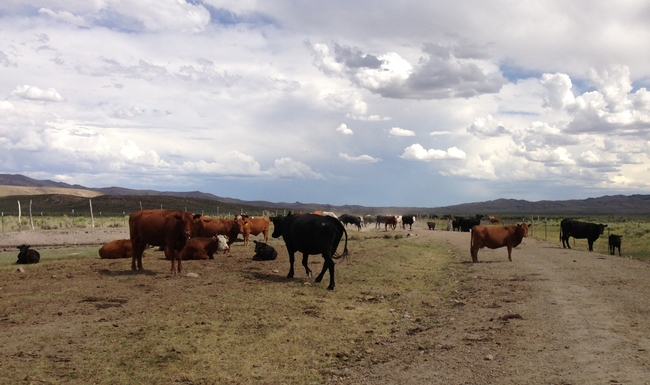
Water quality — Water is the most critical factor in the diet of food animals. When cattle don't drink enough clean and safe water every day, feed intake and productivity declines. Drought conditions can potentially affect all sources of water, including groundwater, but surface waters are especially vulnerable. It is important to frequently monitor water quality, especially as quantity becomes more limited, and test for basic water quality parameters such as total dissolved solids, sodium, sulfates, and nitrates/nitrites. Blooms of blue-green algae in water are also an issue. These cyanobacteria can produce toxins that can affect the liver and nervous system. Depending on the specific toxin and amount ingested, animals may die suddenly, or suffer from weakness, staggering, or photosensitization.
Feed quality and nutritional deficiencies — Drought conditions frequently result in the need to feed poor quality forages or to switch to alternative feed sources. Both can affect animal nutrition and increase the risk for intoxications. Use of poor quality forages can cause or exacerbate deficiencies of important minerals such as selenium, copper, and phosphorus and vitamins such as vitamins A and E. In addition, drought affected forages are often deficient in energy and protein. Even in non-drought years, deficiencies in selenium and copper are common in California cattle, particularly beef cattle. Copper deficiency causes reduced production, diarrhea, decreased resistance to infectious agents and parasites, poor vaccine response, loss of bone strength in calves, weakness and wobbling in neonates, reproductive failure, and sudden death of adult animals. Selenium deficiency also results in less resistance to infectious agents and parasites, and causes white muscle disease of skeletal and heart muscle resulting in stiff gaits, slow movement, heart damage and weak neonates. Primary vitamin A deficiency occurs in beef cattle on dry range pasture during periods of drought. Clinical signs include night blindness, dry eye, retarded growth rate, reproductive failures, and increased mortality. Maternal deficiency of vitamin A can cause abortions, stillbirths, or calves born alive but blind and weak that die within 1 to 3 days. Cows should be given an injection of vitamin A (and D) about 30 days prior to calving and calves should be given a vitamin A injection at birth.
Increased incidence of plant poisonings — Cattle will seek out and consume plants that they would not otherwise find palatable during drought conditions. Nitrate poisoning is one of the most common plant associated intoxications diagnosed by the California Animal Health and Food Safety Laboratory. The potential for nitrate poisoning to occur is increased when livestock water sources also contain elevated concentrations. The first sign of nitrate poisoning is often the sudden and unexplained deaths of one or more animals. Other clinical signs include drowsiness, weakness, muscle tremors, increased heart and respiratory rates, staggering, and recumbency. Signs can develop with several hours of ingesting a toxic amount. Nitrate concentrations can be easily and cheaply determined from samples submitted to a veterinary diagnostic laboratory for testing.
During periods of drought, cattle producers should be especially careful about the quality of feed and water available for their animals. Sick animals should be tested for various nutritional deficiencies and dead animals can undergo necropsies to determine cause of death so that other animals in the herd can be treated appropriately. Additional information and testing is available at the California Animal Health and Food Safety Laboratory System. For laboratory location and contact info, visit www.cahfs.ucdavis.edu. A longer, more detailed version of these tips may be found here.
Robert H. Poppenga and Birgit Puschner, veterinary toxicologists with the California Animal Health and Food Safety Laboratory System at UC Davis School of Veterinary Medicine, contributed to this article.